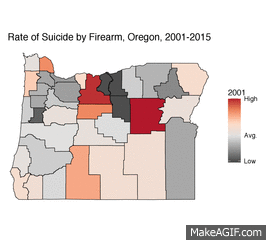I am sure that this has been addressed in other threads, but after half an hour or so of looking, I thought I'd just ask. My apologies in advance.
I am currently looking at suicide rates/100,000 pop by county in a state. The county pops ranges from almost 1 million to ~1,500. As you can imagine, the rates in the smaller counties are highly variable. 3 suicides may result in a rate of 106/100000. I am comparing these rates across counties.
A) Should I weight my data to address this volatility? B) What would be the best way of going about this?
Data are: 36 observations of suicide rate/100,000; 36 observations of county population
edit: This is part of a larger project creating a time-series animation of rates for counties over a 15 year span. Basically, each slide will be a heatmap of suicide rate of each county in the state. I'm trying to create a graphical representation of where rates have been high over time. Would smoothing be useful in creating a more faithful representation?
edit: Here's a version of the time series graphic I'm working on. I would like to remove the volatility of the smaller counties - i.e. make it look less jumpy with the extremes brought more into line. I am relatively inexpert when it come to hard modelling in r, so something simple perhaps if it can retain the overall integrity of the data?

